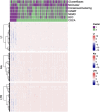Retrotransposon methylation profiles and survival in Black women with high-grade serous ovarian carcinoma
- PMID: 40734190
- PMCID: PMC12309203
- DOI: 10.1186/s13148-025-01942-9
Retrotransposon methylation profiles and survival in Black women with high-grade serous ovarian carcinoma
Abstract
Introduction: Retrotransposons (REs) constitute nearly half of the genome and include long terminal repeat (LTR) elements, Long INterspersed Elements (LINE), and Short INterspersed Elements (SINE). REs are typically silenced in somatic tissues via DNA methylation but can be reactivated through DNA hypomethylation, potentially impacting gene regulation. Here, we investigate genome-scale profiles of RE methylation in high-grade serous ovarian carcinoma (HGSOC) and associations with survival among Black women.
Methods: Methylation levels of LTR, LINE-1, and Alu (type of SINE) in 200 HGSOC tumors were predicted using a random forest approach and clustered using multiple consensus algorithms. Associations between RE methylation clusters and survival were evaluated using Cox proportional hazard regression, adjusting for age, stage, and debulking status. We performed sensitivity analyses restricted to women with late-stage disease and with adjustment for BRCA1/BRCA2 mutations.
Results: Two RE methylation clusters were identified. Cluster 1 exhibited a more hypomethylated RE profile ("Active"), while Cluster 2 was more hypermethylated ("Repressed"). No statistically significant differences in patient or clinical characteristics were observed between clusters. Compared to the Active Cluster, the Repressed Cluster was associated with an increased risk of mortality (HR = 2.41; 95% CI 1.04-5.59) and had a lower proportion of T cells. This association was consistent in sensitivity analyses.
Conclusion: A more hypermethylated RE profile was linked to worse survival among Black women with HGSOC, highlighting the potential of RE methylation as a prognostic biomarker. Further research is needed to understand the underlying biological mechanisms and their implications in ovarian cancer biology and treatment.
© 2025. The Author(s).
Conflict of interest statement
Declarations. Competing interests: LCP reports research funding from Bristol Myers Squibb, Karyopharm, and Janssen unrelated to this work. LS and BC are Advisors and co-founders of Cellintec LLC which had no role in this study. BC is an advisor to Guardant Health which had no role in this study. MLC reports personal fees from Ashcragt & Gerel, unrelated to this work. KLM reports personal fees from Epidemiologic Research and Methods LLC for work unrelated to the present research. JYC reports consulting and speaker’s bureau for Astrazeneca and consulting for Cardinal Health, Rockner Health, and Association of Cancer Care Centers unrelated to this work.
Figures


References
-
- Matteucci C, Balestrieri E, Argaw-Denboba A, Sinibaldi-Vallebona P. Human endogenous retroviruses role in cancer cell stemness. Semin Cancer Biol. 2018;53:17–30. - PubMed
MeSH terms
Substances
Grants and funding
LinkOut - more resources
Full Text Sources
Medical
Miscellaneous

